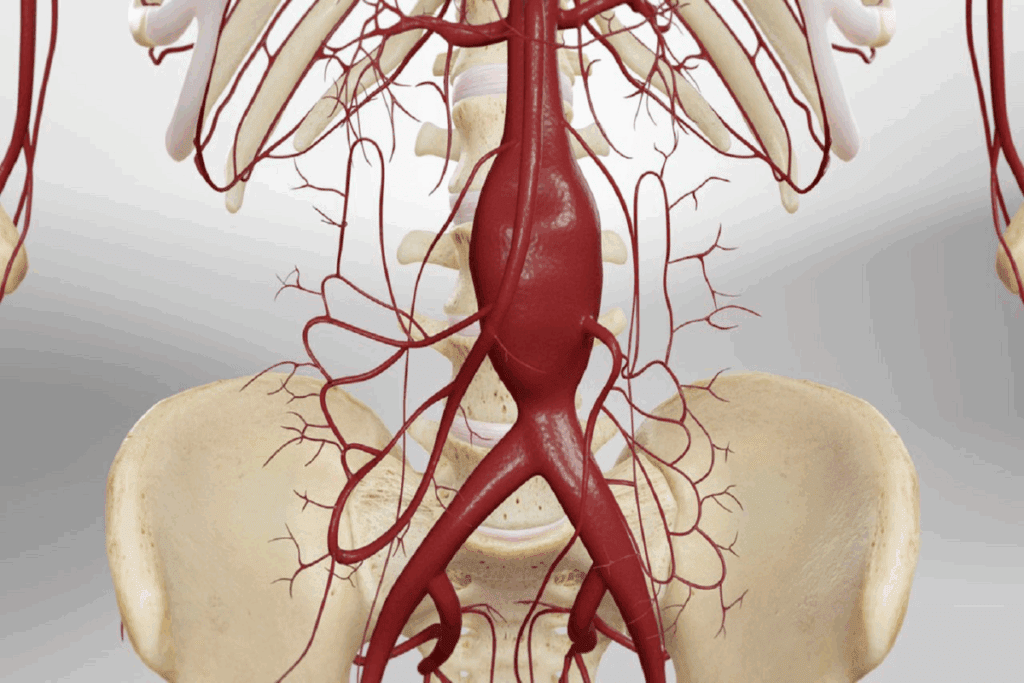Last Updated on November 26, 2025 by Bilal Hasdemir

At Liv Hospital, we know how complex aortic aneurysms are. We also know how vital it is to pick the right treatment. Endovascular aortic aneurysm repair (EVAR) and thoracic endovascular aortic repair (TEVAR) are two cutting-edge, minimally invasive methods. They are used to treat aneurysms in different parts of the aorta.
EVAR is mainly for abdominal aortic aneurysms. TEVAR is for thoracic aortic aneurysms. Both methods use a stent graft placed in the aorta through a catheter. This is done via the femoral artery. This method leads to a faster recovery than traditional open surgery.
It’s key to know the differences between EVAR vs TEVAR to choose the right treatment. Our team of experts is committed to giving personalized care. We aim for the best results for patients with these serious vascular conditions.
Key Takeaways
- EVAR is used for abdominal aortic aneurysms.
- TEVAR is used for thoracic aortic aneurysms.
- Both EVAR and TEVAR are minimally invasive procedures.
- These procedures involve stent graft placement via catheter insertion.
- Understanding the differences between EVAR and TEVAR is key for effective treatment.
Understanding Aortic Aneurysms

An aortic aneurysm is a bulge or weakening in the aorta’s wall. The aorta is the main artery that carries blood from the heart. This condition can cause serious problems if not treated.
Definition and Types of Aortic Aneurysms
Aortic aneurysms are divided into two main types. Abdominal Aortic Aneurysms (AAA) happen below the chest, in the abdomen. Thoracic Aortic Aneurysms (TAA) occur in the chest. Knowing the type helps doctors choose the right treatment, like EVAR (Endovascular Aneurysm Repair) for AAA or TEVAR (Thoracic Endovascular Aortic Repair) for TAA.
Risk Factors and Prevalence
Several things can increase your risk of getting an aortic aneurysm. These include smoking, high blood pressure, atherosclerosis, and a family history of aneurysms. Age is also a big factor, with most cases happening in people over 65. This makes it important to be aware and get screened, as aortic aneurysms are common among the elderly.
Consequences of Untreated Aneurysms
Untreated aortic aneurysms can lead to serious and life-threatening problems. The biggest risk is rupture, which can cause massive bleeding. The chance of rupture goes up as the aneurysm grows. So, finding and treating it early is key.
| Type of Aneurysm | Location | Common Treatment |
| Abdominal Aortic Aneurysm (AAA) | Abdominal region | EVAR (Endovascular Aneurysm Repair) |
| Thoracic Aortic Aneurysm (TAA) | Chest area | TEVAR (Thoracic Endovascular Aortic Repair) |
Traditional Open Surgery vs. Endovascular Approaches

Open surgery was once the only way to fix aortic aneurysms. Now, endovascular methods have changed the game. Open surgery means a big cut in the chest or belly to reach the aorta. It’s been the go-to for years.
Open Surgical Repair: The Historical Standard
Open surgery needs a big cut to get to the aorta. It’s been around for decades and works well but is risky. The invasive nature of open surgery means long hospital stays and more pain after.
Evolution of Minimally Invasive Techniques
New, less invasive methods have become popular. EVAR and TEVAR use a small cut in the groin to put in a stent graft. These methods cut down on recovery time and risks.
EVAR and TEVAR have changed how we treat aortic aneurysms. They let surgeons help patients who were once too risky for open surgery. This is thanks to endovascular techniques.
Paradigm Shift in Aneurysm Treatment
EVAR and TEVAR have changed how we treat aneurysms. They’re less invasive, leading to fewer problems and faster healing. This has made evar surgery and tevar medical abbreviation more common.
Today, we have more treatment options for patients. The choice between open surgery and endovascular repair depends on many things. This includes the patient’s health, the aneurysm’s size and location, and what the patient prefers.
EVAR and TEVAR: Minimally Invasive Solutions
Minimally invasive procedures have changed how we treat aortic aneurysms. They offer safer choices than traditional surgery. We’ll look at two key techniques: Endovascular Aortic Aneurysm Repair (EVAR) and Thoracic Endovascular Aortic Repair (TEVAR).
Defining EVAR: Endovascular Aortic Aneurysm Repair
EVAR fixes an abdominal aortic aneurysm (AAA) through a small groin incision. A stent graft is inserted into the aorta. The stent graft strengthens the aortic wall, stopping the aneurysm from growing or rupturing. It’s great for those at high risk for open surgery or with complex aneurysms.
Defining TEVAR: Thoracic Endovascular Aortic Repair
TEVAR treats thoracic aortic aneurysms in a similar way to EVAR. It uses a stent graft but the approach can vary. TEVAR is best for thoracic aortic aneurysms when open surgery is not suitable.
“The introduction of TEVAR has significantly improved the outcomes for patients with thoracic aortic aneurysms, providing a less invasive option than traditional surgery.”
— Cardiovascular Surgeon
Common Features of Both Procedures
EVAR and TEVAR share some key traits. Both are minimally invasive, using small incisions and stent grafts. They’re done under local or general anesthesia. This reduces recovery time and lowers the risk of complications compared to open surgery.
| Feature | EVAR | TEVAR |
| Aneurysm Location | Abdominal Aorta | Thoracic Aorta |
| Procedure Type | Minimally Invasive | Minimally Invasive |
| Anesthesia | Local/General | Local/General |
| Recovery Time | Reduced | Reduced |
EVAR and TEVAR are big steps forward in treating aortic aneurysms. They offer effective, less invasive options. As technology gets better, we’ll see even more improvements, helping more patients.
Anatomical Considerations: Where EVAR and TEVAR Are Used
It’s important to know where EVAR and TEVAR are used for aortic aneurysms. The location and type of aneurysm play a big role in choosing the right treatment.
Abdominal Aortic Aneurysms (AAA) and EVAR
EVAR is made for treating abdominal aortic aneurysms (AAA). AAA happens when the aorta in the belly gets too big. EVAR is great for patients with AAA who have the right aortic shape, making it a less invasive fix.
The procedure puts a stent graft in the aorta to block blood flow to the aneurysm. This stops it from getting bigger and reduces the risk of rupture. Whether EVAR is right for AAA depends on the aneurysm’s size, where it is, and the patient’s blood vessel health.
Thoracic Aortic Aneurysms (TAA) and TEVAR
TEVAR is for thoracic aortic aneurysms (TAA) in the chest. TAA can be deadly if they burst. TEVAR is a good choice for TAA patients who can’t have open surgery, as it’s less invasive.
Like EVAR, TEVAR uses a stent graft in the thoracic aorta to keep the aneurysm from getting blood. Choosing TEVAR depends on the aneurysm’s size, location, and the patient’s health.
Anatomical Challenges and Considerations
Both EVAR and TEVAR need careful look at the aorta’s shape to work well. Problems like twisted or hard-to-reach vessels can make it hard to put the stent graft in place.
| Anatomical Factor | EVAR Considerations | TEVAR Considerations |
| Aneurysm Location | Abdominal aorta | Thoracic aorta |
| Aortic Neck Characteristics | Crucial for stent graft sealing | Important for stent graft anchoring |
| Vascular Access | Femoral artery access is common | Femoral or iliac artery access may be used |
In summary, picking between EVAR and TEVAR depends a lot on the aortic aneurysm’s shape. Knowing these details is key to picking the best treatment.
The EVAR Procedure in Detail
EVAR, or Endovascular Aneurysm Repair, is a complex procedure. It’s a minimally invasive way to fix abdominal aortic aneurysms. This method is a good alternative to traditional surgery.
Preoperative Planning and Imaging
Before starting the EVAR procedure, we do a lot of planning. We use CT angiography to look at the aneurysm and the area around it. This helps us pick the right stent graft size and shape for the patient’s aorta.
The imaging process includes:
- Detailed CT scans to measure the aneurysm’s size and shape.
- Angiography to check blood flow and find any challenges for placing the stent graft.
- 3D reconstructions to see the aortic anatomy and plan the stent graft.
Step-by-Step EVAR Technique
The EVAR procedure has several steps:
- We access the femoral arteries under local anesthesia.
- We guide catheters and wires to the aneurysm site.
- We place the stent graft to block blood flow to the aneurysm.
- We check the stent graft’s position and make sure there are no leaks.
- We finish the procedure with small incisions, leading to quicker recovery than open surgery.
Types of EVAR Stent Grafts
There are many types of stent grafts for EVAR. Each is chosen based on the aneurysm’s size, shape, and location. We also consider the patient’s vascular anatomy.
Some common stent graft types include:
- Main body stent grafts with modular designs for customization.
- Extension stent grafts for extra support or complex anatomy.
- Stent grafts with active fixation mechanisms for better stability.
Choosing the right stent graft is key to a successful EVAR procedure. It helps improve patient outcomes.
The TEVAR Procedure in Detail
TEVAR is a key treatment for thoracic aortic aneurysms. It’s less invasive than traditional surgery. The procedure uses a stent graft to block the aneurysm from growing or rupturing.
Preoperative Planning and Imaging
Before starting TEVAR, we do a lot of planning. We use CT scans and MRI to look at the aorta. This helps us plan the best way to do the procedure.
We check the size and location of the aneurysm. We also look at the aortic branches and the access vessels.
Step-by-Step TEVAR Technique
The TEVAR procedure happens in a special room with X-ray equipment. Here’s what happens:
- We start by accessing the femoral artery, either through a cut or a needle.
- Then, we use a guidewire to reach the thoracic aorta under X-ray.
- The stent graft is put over the guidewire and placed over the aneurysm.
- Next, we deploy the stent graft, sealing off the aneurysm.
- We might use a balloon to make sure the graft fits well.
- Lastly, we check with X-rays to make sure everything is working right.
Types of TEVAR Stent Grafts
There are many stent grafts for TEVAR, each with its own features. The right one depends on the aneurysm, the aortic branches, and the doctor’s choice.
| Stent Graft Type | Description | Key Features |
| Zenith Alpha | Designed for complex aortic anatomies | Active fixation, robust radial force |
| Gore TAG | Conformable stent graft for thoracic aorta | Flexible design, low profile |
| Medtronic Valiant | Stent graft with proximal bare metal stent | Improved fixation, reduced migration risk |
Knowing about the different stent grafts is key for a successful TEVAR.
Patient Selection Criteria
Choosing the right patients is key for EVAR and TEVAR success. The right candidates depend on their body shape, health history, and overall well-being.
Ideal Candidates for EVAR
EVAR is best for those with abdominal aortic aneurysms (AAA). Ideal candidates have a good neck shape, easy access to iliac arteries, and no major blockages.
Those with tough necks or complex iliac arteries might need other treatments. Or, they might need special endovascular methods.
Ideal Candidates for TEVAR
TEVAR is for thoracic aortic aneurysms (TAA) or other issues in the thoracic aorta. Ideal candidates have the right aorta shape, good access points, and low risk of problems.
TEVAR is often chosen for those at high risk for open surgery. Or for those who have had aortic surgery before.
When Traditional Surgery May Be Preferred
Open surgery might be better than EVAR or TEVAR in some cases. This is for complex aortic shapes, those needing other surgeries, or those with certain tissue disorders.
Younger patients with low surgical risks might also choose open repair. This is because it could last longer.
Clinical Outcomes: EVAR vs. TEVAR
When choosing a treatment for aortic aneurysms, it’s important to look at EVAR and TEVAR outcomes. Both have changed vascular surgery, making it less invasive and more beneficial. But, knowing how well they work in terms of survival, durability, and need for more surgery is vital.
Short-Term Survival Rates
Research shows EVAR and TEVAR both have high survival rates in the short term. EVAR is known for its low risk of death right after surgery, which is good for high-risk patients. TEVAR also has good short-term results, mainly for those with thoracic aortic aneurysms.
Long-Term Durability
Looking at long-term results, both EVAR and TEVAR have shown promise. EVAR might face more late complications like endoleaks and graft migration. TEVAR, though, has shown strong long-term results with fewer late complications.
Reintervention Rates
Reintervention rates help measure the success of EVAR and TEVAR over time. EVAR often needs more surgeries because of issues like endoleaks. TEVAR, while needing follow-up, has fewer surgeries needed.
In summary, EVAR and TEVAR are both good for treating aortic aneurysms, but they have different outcomes. Knowing these differences helps choose the best treatment for each patient.
Potential Complications and Management
It’s important to know the possible problems with EVAR and TEVAR. These procedures are less invasive but can have risks.
Common Complications in EVAR
EVAR has its own set of issues. Some common ones are:
- Endoleak: Blood leaks back into the aneurysm sac around the stent graft.
- Stent Graft Migration: The stent graft moves from its original spot, which might not cover the aneurysm well.
- Vascular injury during access.
Dealing with these problems often needs imaging checks and sometimes more treatments.
Common Complications in TEVAR
TEVAR faces similar issues as EVAR but also has its own dangers. Some common problems are:
- Endoleak: Like EVAR, it’s a big worry.
- Spinal Cord Ischemia: A serious issue for TEVAR, as it can harm the spinal cord’s blood flow.
- Stroke and other brain problems.
Good planning before surgery and watching the patient closely after are key to avoiding these risks.
Post-Procedure Surveillance
Watching patients closely after EVAR and TEVAR is vital. This usually means regular scans to check for any issues.
| Surveillance Component | EVAR | TEVAR |
| Imaging Modality | CT Angiography | CT Angiography, possibly with MRI |
| Frequency | Usually every 6-12 months | Often every 6-12 months, based on first results |
| Purpose | Watch for endoleak, stent migration | Watch for endoleak, stent migration, signs of spinal cord ischemia |
Knowing these possible problems and following a strict watch plan can help improve results for patients having EVAR and TEVAR.
Recovery and Follow-Up Requirements
Recovering from EVAR or TEVAR is a detailed process. It includes immediate care, long-term checks, and lifestyle changes. A smooth recovery is key to the treatment’s success.
Immediate Post-Operative Care
Patients are watched closely in a recovery unit for hours to overnight after EVAR or TEVAR. Immediate post-operative care focuses on pain management, watching for complications, and checking the patient’s health.
Important parts of immediate care are:
- Monitoring vital signs and neurological status
- Pain management through medication
- Looking for signs of complications like bleeding or endoleak
- Encouraging early movement to prevent blood clots
Long-Term Monitoring Protocols
Long-term checks are vital to make sure the EVAR or TEVAR works well. Regular follow-up appointments help watch the aneurysm sac for any issues.
A typical long-term check includes:
- Imaging studies like CT scans or ultrasound at set times (e.g., 1, 6, and 12 months after, and every year after that)
- Checking kidney function and heart health
- Looking at any symptoms or worries the patient has
- Changing medications as needed to manage heart risks
| Follow-Up Item | Frequency | Purpose |
| CT Scan or Ultrasound | 1, 6, 12 months, then annually | Monitor for endoleak, sac size |
| Renal Function Tests | At each follow-up visit | Assess kidney health |
| Cardiovascular Risk Assessment | At each follow-up visit | Manage risk factors |
Quality of Life Considerations
The effect of EVAR or TEVAR on a patient’s quality of life is important. Most patients get better quickly and can do normal things in a few weeks.
Things that affect quality of life include:
- Any complications or need for more surgery
- The patient’s overall health and other health issues
- Following recommended lifestyle changes and taking medications
By managing these, healthcare providers can improve patient outcomes and quality of life after EVAR or TEVAR.
Cost Considerations and Insurance Coverage in the US
It’s important to know the costs of EVAR and TEVAR before deciding. These treatments can be pricey, and insurance coverage varies.
Average Costs
The cost of EVAR and TEVAR can change based on several things. This includes how long you stay in the hospital, the type of stent graft, and doctor fees. On average, EVAR costs range from $30,000 to $50,000. TEVAR can cost more, from $40,000 to $70,000 or more. These prices include tests before surgery, the surgery itself, hospital stay, and care after surgery.
Insurance Coverage
Medicare and private insurance cover EVAR and TEVAR, but how much they cover can differ. Medicare usually covers a lot of the costs for those who qualify. This includes having the right kind of aneurysm and being at high risk for open surgery. Private insurance can vary a lot, with some plans covering more than others.
It’s key to check your insurance before getting either procedure. You should know about any costs you might have to pay, like deductibles and copays. Also, find out if you need pre-approval.
Financial Factors in Procedure Selection
When picking between EVAR and TEVAR, money matters a lot. But it’s not the only thing to think about. You and your doctor should also think about possible complications, the chance of needing more surgery, and how it might affect your life.
- Cost Comparison: Look at the costs of EVAR and TEVAR, including everything.
- Insurance Coverage: Know how much insurance covers for both procedures.
- Financial Assistance: See if there are programs or services to help with money issues.
By looking at these things, you can make a smart choice about your treatment. This way, you get the care you need while managing your money.
Conclusion
EVAR and TEVAR have changed how we treat aortic aneurysms. They offer new, less invasive ways to fix these problems. These methods need careful planning, precise execution, and ongoing care to work well.
Research shows EVAR and TEVAR can make arteries stiffer. TEVAR makes arteries 2–5 m/s stiffer, while EVAR makes them 1–3 m/s stiffer. The length of the stented area also matters, with longer parts having bigger effects.
A study on PubMed Central found that the material of the endograft matters. PTFE-based endografts cause less post-implantation syndrome than polyester-based ones.
As we keep improving endovascular surgery, new materials might solve current problems. Our talk shows EVAR and TEVAR are key in fixing aortic aneurysms. It’s vital to keep up with care and monitoring for the best results.
FAQ
What is the difference between EVAR and TEVAR?
EVAR and TEVAR are both ways to fix aortic aneurysms. EVAR fixes the belly area, while TEVAR fixes the chest area. They are both less invasive than traditional surgery.
What is an aortic aneurysm?
An aortic aneurysm is a bulge in the aorta. It’s the main blood vessel from the heart to the body. If it bursts, it can cause severe bleeding and be deadly.
What are the risk factors for developing an aortic aneurysm?
Risk factors include age, smoking, high blood pressure, family history, and certain genetic conditions. Knowing these helps catch aneurysms early.
How are EVAR and TEVAR performed?
These procedures start with small cuts in the groin. A stent graft is then put in to block the aneurysm. This stops it from getting bigger or bursting.
What are the benefits of EVAR and TEVAR compared to open surgery?
EVAR and TEVAR are less invasive. They mean shorter hospital stays, less pain, and faster recovery. They also lower the risk of surgery complications.
What are the possible complications of EVAR and TEVAR?
Complications include endoleak, stent graft issues, and vascular problems. Regular check-ups are key to catch these early.
How often are follow-ups required after EVAR or TEVAR?
Follow-ups, like CT scans, are needed to check the aneurysm and stent graft. The frequency depends on the doctor’s advice.
Are EVAR and TEVAR covered by insurance in the US?
Yes, most insurance plans, including Medicare, cover EVAR and TEVAR for eligible patients. But, it’s best to check with your insurance.
What is the average cost of EVAR and TEVAR procedures in the US?
Costs vary based on provider, location, and patient needs. But, insurance can help lower the cost for those who have it.
Can EVAR or TEVAR be repeated if necessary?
Yes, sometimes more treatment is needed if complications happen or if the aneurysm doesn’t get better. The decision to do more is made for each patient.
What is the recovery time like after EVAR or TEVAR?
Recovery is faster than with open surgery. Most people can get back to normal in a few weeks. But, always follow your doctor’s recovery plan.
Reference
- Yoon, W. J., et al. (2019). Fenestrated endovascular aneurysm repair versus snorkel EVAR for complex aneurysms: A review. PMC.






